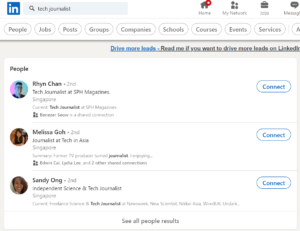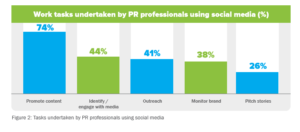How to pitch your press release to journalists
For our 49th SpudsMeet session, we invited Agung S. Ongko, Head of Lab360 and Strategy Director at Rice Communications.

As part of Potato Productions’ employee learning, we invite external speakers who will share their expertise with us during our Spuds Meet event. For our #49 session, we invited Agung S. Ongko, Head of Lab360 and Strategy Director at Rice Communications, who shared with us the basics of Media Relations.
Read on to find out more about what he shared, coupled with research and insights from journalists and PR professionals.
Having a good or bad reputation can make or break your business.
To get ahead of your competitors and put your name out there, your business needs to be seen on the pages of the news; readers trust the media as they are neutral and credible sources.
This means regular, positive media coverage of your business in the news. It sounds great, but unless you are one of the huge fortune 500 companies or you have created a revolutionary business, your media pitch will constantly be competing with other pitches landing in the inboxes of journalists.
It’s not good enough to mass send your press releases to journalists, praying that one of them will be interested enough to pick it up. You need to understand nuances of the media pitching game to own it.
Understand journalists’ mindset
According to research by Fractl, 46.5% of journalists receive at least 11 pitches and 28.64% receive over 26 pitches per day.
That’s why you need to send the right pitch, to the right person, at the right time.
And just because something is important doesn’t mean it’s newsworthy. It might seem like a great story to you, but from a journalist’s point of view, it might not be relevant to their target audience.
Just throwing your facts, awards or statistics is not going to make a compelling story. You need to craft an angle that will interest the journalists’ audiences. Start by considering these:
1. What are their drivers and motivations?
By understanding what they care about, you will be able to pitch your story with a compelling angle.
Journalists care about:
-
Breaking news
This is the sort of news that is going to land on the front page of the publication. As journalists’ names are tied to their stories, it’s even better if the topic is trending and stays in the newspaper for days or weeks. This increases their visibility and elevates their reputation.
-
New insights or perspective on a trending or hotly debated topic
A journalist from Straits Times shared that relevance is key when it comes to crafting an angle for your story. If you are able to tie your content to trending topics, such as Covid or vaccination, or hotly debated topics such as privacy rights, it makes your content relevant and interesting to audiences.
Playlogue Creations created a board game ‘Fly-A-Way’ on bird migration last year and managed to get several press coverage on publications such as TODAY and Mothership. They pitched their new product to journalists by tying it to a greater cause – bird conservation and climate change challenges. Since bird conservation is a cause that people advocate and care about, there was a greater chance for journalists to pick it up. It also helped that their product was pitched late in the year during the bird migration season, which was a topic of interest.
-
Challenging conventions and debunking myths
Harsh Dalal, CEO of Team Labs, was named in Forbes 30 under 30 Asia list for 2021 and the success story of the 19-year-old founder was previously covered by CNA. But doubts about his story were cited by the Singapore Reddit community and Tech in Asia broke the story of the inconsistencies in his narrative, and reported findings that suggested his story might have been bogus.
Tech in Asia’s article was brought into the spotlight for being the first publication that debunked the success story of this envied founder. They presented another side of the story, one that rivaled Forbes, a big international news outlet. Not only were they the fastest, they challenged a trending story with their new findings, bringing their own value to the table.
2. What kind of stories are newsworthy?
‘Put yourself in the editors’ shoes. Which email title (or article title) would you be more drawn to? “Press Release: Company A develops new mask for better protection against COVID-19” or “Press Release: New mask reduces the likelihood of COVID-19 infection by 50%”’ – Josephine Yeo, a senior PR practitioner shares.
It’s very likely that the second option would capture your attention.
Why?
It has a number tied to it and is related to a trending topic, making it more impactful. And being impactful is one of the elements that appeals to audiences.
Typically, these are the elements that make a story newsworthy:
– Timeliness – Recent events are more likely to be covered.
– Impactful – Were lives or livelihood affected? Is there a dollar value tied to it?
– Proximity – Is it near your audiences’ neighbourhood?
– Prominence – Did a celebrity or minister attend?
– Human Interest – Emotional appeal
– Novelty/ Oddity – Is it something unexpected?
Consider if your story contains any of these elements. If it does, shine the spotlight on these!
Pitch your story well
After knowing what appeals to them, get a deeper understanding of the media’s target audience and tailor your pitch accordingly.
-
Angle your story based on who you are sending it to
Ask yourself: who are their readers and what do their readers want to read about?
‘It is good practice to angle your press release based on those two aspects and also on the type of media that you are pitching to. If it is to a business desk, be sure to have numbers, data, and business-skewed points. If it is to a lifestyle desk, it could be less daunting, more engaging, and catered for light reading. You can start by checking in on what topics interest them or what angles are they on the lookout for,’ says Josephine Yeo, senior PR practitioner.
-
Send your pitch in a proper format
In your email, summarise your main points in a few paragraphs. Journalists would not read a long-winded email with chunks of information.
List your most impactful points first to capture their attention, followed by the context, and the background.
Know WHO to approach
Establishing relationships and connecting with RIGHT people helps you to get your news out there. With a large number of journalists and news outlets, you should know who to prioritise engaging with.
A quick search on ‘(topic) journalist’ can give you an array of individuals whom you might want to connect with!
 |
Alternatively, go to an article written by them and click on their name to get to their by-line page. Take a look at all the articles that they have written and find out if they have written about a topic that you are interested to pitch for. If they have, it is a good indication that your pitch will resonate better with them compared to other journalists.
You should also familiarise yourself with the hierarchy of the newsroom. If you were to approach a Managing Editor of an editorial team, I’m afraid you are not going to get the results you are looking for. The Managing Editor plans out the overall tone and strategic objective – think of them as your C-level suites. They are not the ones who will pitch stories or remember who you are.
 |
The people whom you should pitch to are the beat/desk editors, correspondents and reporters.
By knowing their role in a newsroom, you can change the way you approach them. For instance, you can appeal to a beat or desk editors’ industry expertise as they are the industry experts. Whereas for correspondents and reporters who are in charge of chasing and pitching stories to the higher-ups, build relationships and strengthen your connections with them as they are the ones who are hungry to earn the badge of honor. Show them your value by giving them your best stories!
How to build relationships with journalists?
If someone asks you a favour the first time they meet you, there’s a high chance you will find that distasteful. So don’t do it to others!
As cliche as it sounds, build relationships with journalists and it will benefit you in the long run.
Here are some of the ways you can do so:
-
Find and connect with them on social media
According to research done by Smart Insights, 44% of PR specialists use social media to identify and engage with media professionals.
 |
Credit: Smart Insights
Facebook and Instagram are more reserved for close friends and personal networks, but LinkedIn and Twitter are good platforms for you to leverage on.
-
Read their stories and show interest
Find out the topics that they are usually interested in covering. Read their articles to understand more about their news angle and writing style.
It’s easier to take the first step and approach them when you have a topic that you can discuss. Share with him or her about your perspective on an article that they have written or ask them questions (smart ones). This shows that you took the effort to prepare in advance.
-
Shared interests are great conversation starters
Common interests are great conversation starters. An immediate attention grabber.
Be it meeting them for a coffee session or sending them a cold media pitch, you can start by referencing something that you are both interested in.
-
Engage with them regularly
Don’t only contact them when you need help. Show them your value by sharing knowledge about the industry that they are interested in. You can post industry updates on twitter or drop them a short message to keep them abreast.
When journalists post their articles online, share with them your perspective by commenting or help them reshare their post. If it’s the first time you are engaging with them, that would be a great way to get on their radar. And even if you have known them for a while, engaging with their content can remind them of your presence and further deepen your relationship. It is more likely for them to think of you for an important quote or news when they need sources for relevant articles they might be working on.
For more tips on connecting with journalists, check out this article by PR Daily.
